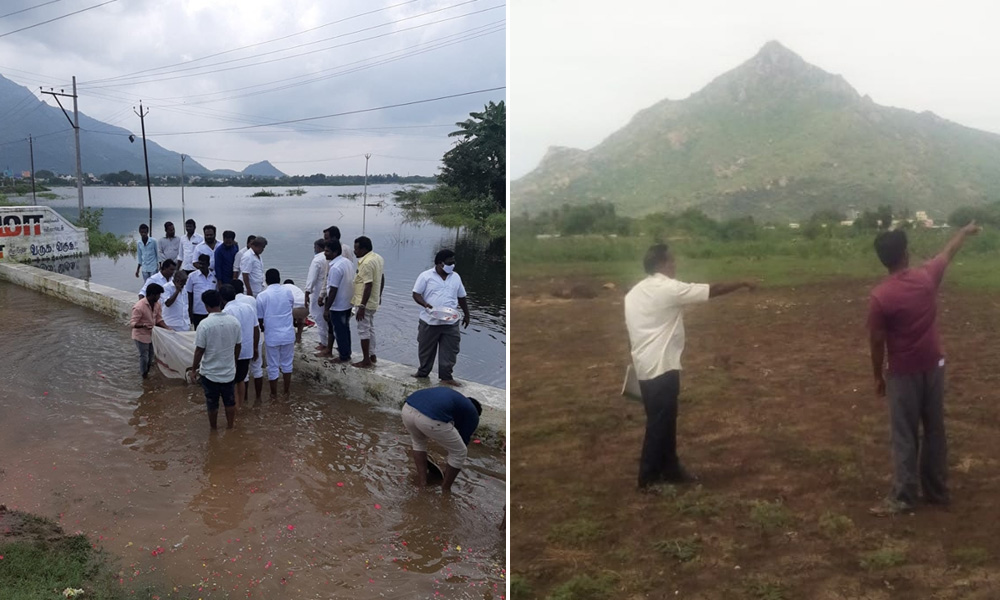
Image Credit: Ganeshraja Muthukrishnan
Tamil Nadu: Locals, NGOs, Govt Join Hands To Restore Vengikkal Lake
Tamil Nadu, 2 July 2021 10:31 AM GMT | Updated 2 July 2021 10:32 AM GMT
Editor : Madhusree Goswami |
A mountain girl trying to make it big in the city. She loves to travel and explore and hence keen on doing on-ground stories. Giving the crux of the matter through her editing skills is her way to pay back the journalism its due credit.
Creatives : Anuran Sadhu
A post grad journalism student of SIMC, Pune with a passion for using words to get my message across in the most unique ways possible and curiosity is the force that drives me to learn and experience more every day.
The lake which had fallen prey to encroachment and neglect was restored, thanks to efforts of the local people, NGOs and district administration. Around 300 such water bodies in Tiruvannamalai district will be restored next.
Tiruvannamalai, an industrially backward district in Tamil Nadu, has just under 25 lakh people. Most of the urban population in the district live in the temple town of Tiruvannamalai, a popular tourist and pilgrim spot in the state. Owing to Rajinikanth's movie 'Annamalai' in 1997 and his frequent visits to the Lord Arunachaleeswara temple on full moon days, the town witnessed a surge in tourists visiting the area from not only other parts of Tamil Nadu but from other states as well.
Depleting Water Sources
Over the last two decades, Tiruvannamalai witnessed a surge in the migration of labour due to tourism and the economic growth that followed. The population of the town increased by almost 50 per cent in over 15 years. The extended areas of the town also merged with the nearby taluks. However, the district has no perennial rivers and the river beds of the small rivers are usually dry throughout the year. The town receives rainfall between August and November, with an average rainfall of 104 cm a year. The expansion of the town's limits and an increase in the population has resulted in water shortage.
In 2019, the district administration decided to intervene. With the help of the Central government's Jal Shakti Abhiyan programme, they took the initiative to solve the water crisis by rejuvenating the existing 300 water bodies in the district.
One such project was to restore the Vengikkal Lake opposite the District Administration office in Tiruvannamalai town. The lake is capable of holding 10 million litres of water and is spread across 125 acres of land. It has 25 bore wells and six open wells that cater to 2,000 people living in the nearby areas.
The lake had been shrinking in size. Since 2015, the water body became completely dry due to the expansion of real estate and blocking of water sources. Even after heavy rainfall in 2015, the lake did not fill up. Therefore the restoration of this lake became a top priority for the district administration.
The Challenges Faced And The Actions Taken
A majority of the lake's water source fell in the areas inhabited by migrants whose claim to the land is still under dispute. Therefore, the district administration roped in NGOs and volunteers to help them with the project. Through gram sabha meetings and door-to-door campaigns, the volunteers successfully roped in the local as well. The villagers were promised income by fishing in the lake. The NGOs and the volunteers also contributed funds to complete the restoration project.
On its part, the district administration helped the NGOs and volunteers with necessary resources to identify water sources, boundary marking, removal of weeds, de-silting, and construction of the bund of the lake. With this, the lake's capacity was increased to hold an additional 10 million litres of water.
Soil that was dredged out of the lake was used to construct roads and a nearby government building. The district administration also made efforts to beautify the lake and built a science park for adults and kids along the lake.
In the summer of 2019, the lake bed was hot and dry. Cut to two years later, the lake is brimming with water and life. The water table in the nearby area is said to have increased by five to 10 feet. This rejuvenation project is a perfect example of how the joint efforts of the administration and the local community can bring benefits to society.
Also Read: 4,500 Acres Of Lake Land Encroached In Bengaluru, Survey Says Number Might Increase
 All section
All section














